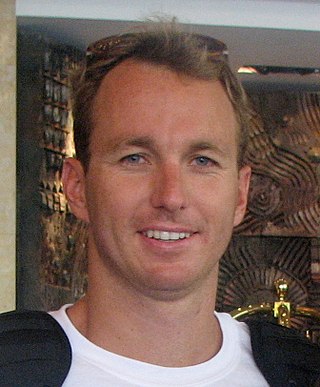
The men's 200 metre backstroke event at the 2004 Olympic Games was contested at the Olympic Aquatic Centre of the Athens Olympic Sports Complex in Athens, Greece on August 18 and 19. There were 36 competitors from 30 nations. Each nation had been limited to two swimmers in the event since 1984.
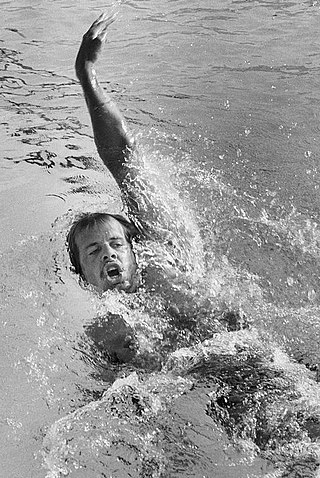
The men's 200 metre backstroke event for the 1976 Summer Olympics was held in Montreal. The event took place on 24 July. There were 33 competitors from 23 nations, with each nation having up to 3 swimmers. The event was won by John Naber of the United States in world-record time; he was the first person to swim the event in under 2 minutes (1:59.19). It was Naber's fifth medal of the Games: completing a double in the backstroke events as well as golds in the medley relay and the 4×200 free relay, along with a silver in the 200 free. It was the second American victory and second American medal sweep in the men's 200 metre backstroke, after 1968; of the 12 medals from 1968 through 1976, 10 were won by Americans and the other two by Roland Matthes. Peter Rocca (silver) and Dan Harrigan (bronze) were the other two Americans, along with Naber, to reach the podium in 1976. The rules changed in 1984 to limit nations to two swimmers each, preventing further sweeps.

The men's 200 metre backstroke event at the 1996 Summer Olympics took place on 26 July at the Georgia Tech Campus Recreation Center in Atlanta, United States. There were 39 competitors from 33 nations. Each nation had been limited to two swimmers in the event since 1984. The event was won by Brad Bridgewater of the United States, with his countryman Tripp Schwenk taking silver. It was the first time since 1980 that one nation had two swimmers on the podium in the event. Bridgewater's victory was the United States' first in the event since 1984 and fourth overall. Italy earned its second consecutive bronze medal in the men's 200 metre backstroke, with Emanuele Merisi taking the honours this time.

The men's 200 metre backstroke event at the 1984 Summer Olympics was held in the Uytengsu Aquatics Center in Los Angeles on July 31, 1984. There were 34 competitors from 25 nations, with each nation limited to two swimmers. The event was won by Rick Carey of the United States, the nation's third victory in the men's 200 metre backstroke. Frédéric Delcourt of France took silver and Cameron Henning of Canada earned bronze; it was the first medal in the event for each of those two nations.
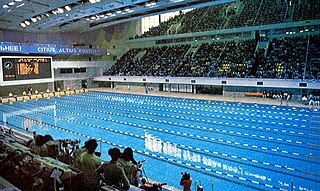
The men's 200 metre backstroke event at the 1980 Summer Olympics was held on 26 July at the Swimming Pool at the Olimpiysky Sports Complex. There were 25 competitors from 16 nations, with each nation having up to three swimmers. The event was won by Sándor Wladár of Hungary, with his countryman Zoltán Verrasztó taking second. Mark Kerry of Australia earned bronze. They were the first medals in the event for both nations. The United States' four-Games podium streak ended due to the American-led boycott.
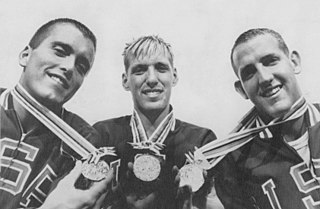
The men's 200 metre backstroke event at the 1964 Summer Olympics took place between October 11 and 13. There were 34 competitors from 21 nations, with each nation having up to 3 swimmers. The medals were swept by the United States, with Jed Graef, Gary Dilley, and Bob Bennett taking gold, silver, and bronze respectively.
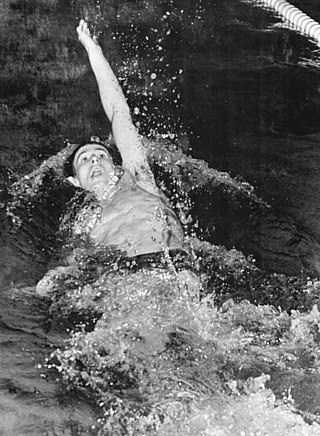
The men's 200 metre backstroke event at the 1968 Summer Olympics took place on 25 October at the Alberca Olímpica Francisco Márquez. There were 30 competitors from 21 nations, with each nation having up to three swimmers. The event was won by Roland Matthes of East Germany, the second gold medal for a German swimmer after Ernst Hoppenberg won in 1900. Matthes completed the backstroke double in the first Games both events were held, with Olympic record times in both. The United States, which had swept the podium in 1964, finished in the next three places behind Matthes: Mitch Ivey took silver, Jack Horsley bronze, and Gary Hall Sr. 4th.
The men's 200 metre individual medley event at the 1968 Olympic Games took place between 19 and 20 October. This swimming event used medley swimming. Because an Olympic size swimming pool is 50 metres long, this race consisted of four lengths of the pool. The first length was swum using the butterfly stroke, the second with the backstroke, the third length in breaststroke, and the fourth freestyle. Unlike other events using freestyle, swimmers could not use butterfly, backstroke, or breaststroke for the freestyle leg; most swimmers use the front crawl in freestyle events anyway.
The women's 100 metre freestyle event at the 1968 Olympic Games took place between 18 and 19 October. This swimming event used freestyle swimming, which means that the method of the stroke is not regulated. Nearly all swimmers use the front crawl or a variant of that stroke. Because an Olympic-size swimming pool is 50 metres long, this race consisted of two lengths of the pool.
The inaugural women's 200 metre freestyle event at the 1968 Olympic Games took place between 21 and 22 October. This swimming event used freestyle swimming, which means that the method of the stroke is not regulated. Nearly all swimmers use the front crawl or a variant of that stroke. Because an Olympic size swimming pool is 50 metres long, this race consisted of four lengths of the pool.
The women's 400 metre freestyle event at the 1968 Olympic Games took place between 19 and 20 October. This swimming event used freestyle swimming, which means that the method of the stroke is not regulated. Nearly all swimmers use the front crawl or a variant of that stroke. Because an Olympic-size swimming pool is 50 metres long, this race consisted of eight lengths of the pool.
The women's 100 metre backstroke event at the 1968 Olympic Games took place between 22 and 23 October. This swimming event used backstroke. Because an Olympic-size swimming pool is 50 metres long, this race consisted of two lengths of the pool.
The women's 100 metre breaststroke event at the 1968 Summer Olympics took place between 18 and 19 October in the Alberca Olímpica Francisco Márquez. This swimming event used the breaststroke. Because an Olympic size swimming pool is 50 metres long, this race consisted of two lengths of the pool. This was the first appearance for this event in the Olympics for the women swimmers.
The women's 200 metre individual medley event at the 1968 Summer Olympics took place 20 October. This swimming event used medley swimming. Because an Olympic size swimming pool is 50 metres long, this race consisted of four lengths of the pool. The first length was swum using the butterfly stroke, the second with the backstroke, the third length in breaststroke, and the fourth freestyle. Unlike other events using freestyle, swimmers could not use butterfly, backstroke, or breaststroke for the freestyle leg; most swimmers use the front crawl in freestyle events anyway.
The women's 400 metre individual medley event at the 1968 Summer Olympics took place on 24–25 October. This swimming event used medley swimming. Because an Olympic size swimming pool is 50 metres long, this race consisted of eight lengths of the pool. The first two lengths were swum using the butterfly stroke, the second pair with the backstroke, the third pair of lengths in breaststroke, and the final two were freestyle. Unlike other events using freestyle, swimmers could not use butterfly, backstroke, or breaststroke for the freestyle leg; most swimmers use the front crawl in freestyle events.
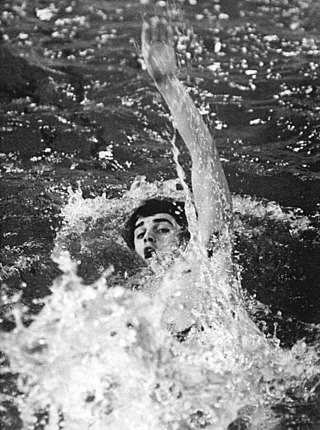
The men's 200 metre backstroke event at the 1972 Summer Olympics took place on September 2 at the Olympia Schwimmhalle. There were 36 competitors from 23 nations, with each nation having up to 3 swimmers. The podium was very similar to the previous Games in 1968, with Roland Matthes of East Germany winning gold and the United States taking the other two medals, including one going to Mitch Ivey. Matthes and Ivey were the first two men to earn multiple medals in the event, with Matthes the first to win back-to-back championships and Ivey adding his 1972 bronze to his 1968 silver. Mike Stamm was the silver medalist in Munich. Matthes also defended his 1968 100 metre backstroke title, giving him the backstroke double a second time.
The women's 200 metre freestyle event at the 1972 Olympic Games took place September 1. This swimming event used freestyle swimming, which means that the method of the stroke is not regulated. Nearly all swimmers use the front crawl or a variant of that stroke. Because an Olympic size swimming pool is 50 metres long, this race consisted of four lengths of the pool.
The women's 200 metre backstroke event at the 1972 Olympic Games took place September 4. This swimming event used backstroke. Because an Olympic-size swimming pool is 50 metres long, this race consisted of four lengths of the pool.
The women's 200 metre individual medley event at the 1972 Olympic Games took place August 28. This swimming event used medley swimming. Because an Olympic size swimming pool is 50 metres long, this race consisted of four lengths of the pool. The first length was swum using the butterfly stroke, the second with the backstroke, the third length in breaststroke, and the fourth freestyle. Unlike other events using freestyle, swimmers could not use butterfly, backstroke, or breaststroke for the freestyle leg; most swimmers use the front crawl in freestyle events anyway.
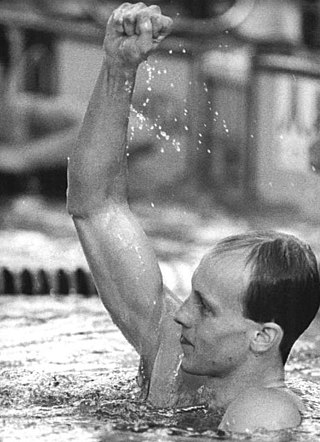
The men's 200 metre backstroke event at the 1988 Summer Olympics took place on 22 September at the Jamsil Indoor Swimming Pool in Seoul, South Korea. There were 44 competitors from 32 nations. Each nation had been limited to two swimmers in the event since 1984. The event was won by Igor Polyansky of the Soviet Union. Frank Baltrusch of East Germany took silver, while Paul Kingsman of New Zealand earned bronze. The medals were the first in the men's 200 metre backstroke for the Soviet Union and New Zealand; East Germany had not medaled in the event since Roland Matthes won gold in 1968 and 1972. For the first time, the United States competed and did not earn at least silver.









